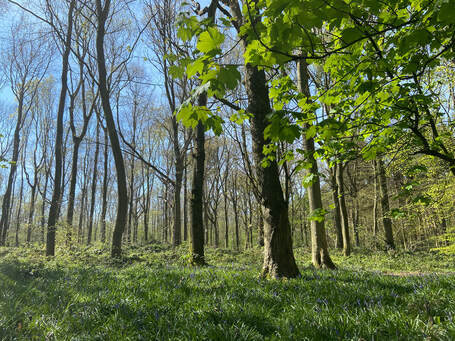|
I was out on my daily walk yesterday, and about a mile in, the incessant mental chatter that is always my early companion began to cease. Meditation teachers speak of the magic ‘8 minute mark’- the moment when the usually ceaseless wandering of the mind naturally starts to settle when in meditation. Whilst walking alone, the same thing happens to me about a mile in.
I especially love that moment, when the irritations of mental meandering gives way to the space that comes with more just simply noticing. And in this case, I was spoilt for choice. Spring has sprung this week with a force that is nearly unsteadying. A landscape that was still holding on to its monochromes and its silhouettes only a week ago, is now acid greening by the day- as though someone has been overzealous with a green paintbrush, not that i imagine you could ever be too so. The primrose still edging the hedges have now been joined by bluebells within them, and the buds of wild apple have either burst or threaten to - part of me fears turning away too long lest we miss it. And the air smells different, now laden with scent that is so heavy you cant distinguish its particular threads anymore; it is both heady and intoxicating, as is the hum of insect life, brought to sound by the unusually warm days that have been one of the blessings of lockdown. And it struck me then and there, that the seasons have no idea about COVID-19. They haven't heard of coronavirus and they certainly aren't in lockdown. Whilst the human world has been turned on its head, the natural world has - unencumbered by our busyness and with not so much as a skipped beat- continued to tread its own reassuring rhythm. Winter giving itself up for spring, or for those in the southern hemisphere, summer stepping gradually aside to make way for autumn. As it does, in the way that it has always done. As my Buddhist teacher Geshe Tasha says, these are the teachings of Buddhism in action. All that is superfluous has fallen away and we are left with the underlying. Turning to what is - by nature- more essential is at the very heart of Eastern spiritual teachings. Their counsel has always been to not place too much reliance on the house of cards that is the external world. They have long suggested that real delight and well being comes from digging a little deeper. We often nod in the face of such lessons, whilst still merrily clicking the buy button on another piece of clothing or another experience, overfilling our diaries to such an extent that they crowd out everything else. But I have been struck as a teacher how in lockdown, people are infinitely more open to suggestions than they ever were. What was hearsay is now actual lived experience, and there is no better teacher. All that is truly fleeting has now being exposed. In the same way that society has come to understand who the key workers actually are, who we most need in a time of crisis, we are being guided - by necessity of not by design- to find what is more essential and enduring. The more underlying rhythms that are still within the reach of a locked down life. The things that can not be cancelled. The unfurling seasons. Or the dawns and dusks that we now have more time to drink in, no longer shrouded as they usually are by a rushed start to the day or a distracted commute. The waxing and waning of the moon, mapping out twenty eight days and lending its rhythm to the tides, over and over, whether we are there to notice it or not. And if lockdown is calling for even more reflective depth, then we could do worse than to look towards our own river of breath. Mostly ignored as we go about our normal lives, our breath is nonetheless our constant companion. It is no accident that it is used as an object of meditation across so many traditions. Free, always available,the breath serves as both a barometer and a tool. Turn to your breath and you get an immediate snapshot of how you are. Are you breathing high up in the chest, a sign perhaps of your resistance to all of this change? Does your shallow breathing attest to your understandable anxiety? Or is your breath long and languid, freed of its usual burdens of busy? And then in the face of what you find, can you start to edge towards a softer rhythm. Can you direct the breath to places that seem to hold tension within the body? Can you use the breath as a soft focus, becoming aware of the way in which the mind dances around it? Can you seek simple solace in the undulations of the breath, in the constant ribbon of inhale followed by exhale that exists entirely beneath and beyond the more unreliable material world. To help to turn inwards, I am attaching a breath based meditation for you all to practice. It is short, so simply an introduction but you can choose to pause it at any point and extend the time that you notice the breath. |
|
